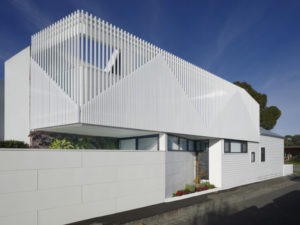Project Description
This summerhouse near São Paulo was built for a couple with three grown-up daughters. It had to conciliate the dichotomy between framing astonishing views to a golf course and woods towards the dark south and seeking abundant light on the street side, towards north. The solution was to arrange the spaces following the latitudinal axis of the plot in a manner that would provide framed views to the landscape and bring the sunlight altogether.
The house is divided in two sections: on one side there are four bedrooms for the daughters and guests. They open towards a long corridor with a glass wall facing south and are protected by wooden louvers in front of a dense garden facing north. On the other side, social areas form one single common space integrated with the surrounding context. The dry climate of the region led to the creation of a small pond that embraces the house. It is 50 centimeters deep, containing fishes and plants able to keep the water naturally clean. Several rocks create a particularly astonishing atmosphere and part of the pond was deepened to be used as a swimming pool.
The wood flooring in the private areas is replaced by rough stone in the common areas. The living room has a high wood ceiling of 3.6 meters that brings warmth to the house and extends to the outside, connecting interior and exterior. A lower wooden volume next to the living room holds a powder room and a cellar. The horizontality of the space is highlighted by a succession of layouts that comprehend an entrance hall, a living room with a hearth and a dining room, all along the exterior terrace. A continuous zenithal slit that lightens the opposite side of the space is a technical prowess with no beams crossing its path. The connection between both spaces is enhanced by glass doors that slide within the walls and disappear from view. Further, next to this room, a gourmet kitchen and a home theater can also be integrated through sliding walls. Outside, the wooden deck conceals a Jacuzzi underneath the floor. Next to it, a ground hearth made of stone stands as the perfect spot for gathering on clear nights.
The stairs that lead to the master suite and the atelier on the first floor becomes a sculpture with its floating steps underneath a large glass ceiling, transforming the atrium into a courtyard. The volume of this floor, covered with vertical wood louvers of different widths, contrasts with the long horizontal lines of the brick walls of the first floor. The rusticity of the house is highlighted by the washed tones of the bricks, playing with the shadows under the strong tropical light. All the frames employed in glass doors and windows are very narrow, with a 2 cm square section, becoming almost imperceptible, even when closed.


















































































